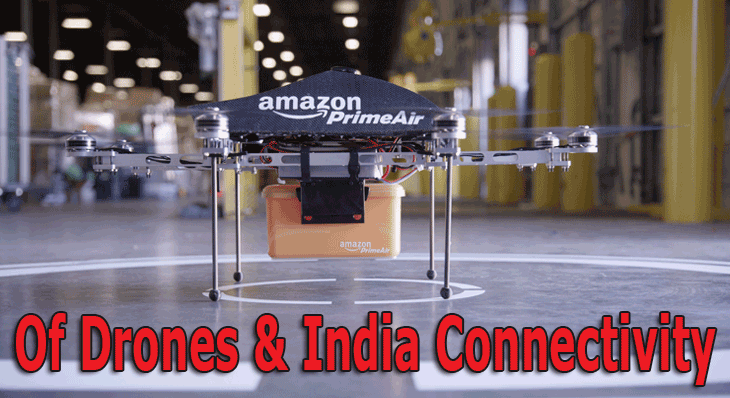| 
FlyingTypers has learned that
despite India’s Directorate General of Civil Aviation (DGCA) ban
on civilian drones, Amazon India continues to advance its case to implement
a Prime Air drone project for package deliveries within the 2.26 kg weight
in Mumbai and Bengaluru.
Banned in the USA, Amazon had hoped
to take advantage of lax Indian laws and had been testing drones in India
since this past summer.
The e-commerce giant announced
sometime ago that it was pumping $2 billion into the Indian market to
strengthen its infrastructure.
It’s
About Connectivity
 The
Indian government’s moves to connect the furthest corners of the
country received a boost with the release of an in depth report, “Civil
Aviation - Developing Remote & Regional Connectivity.” The
Indian government’s moves to connect the furthest corners of the
country received a boost with the release of an in depth report, “Civil
Aviation - Developing Remote & Regional Connectivity.”
The report—a result of a
strategic association between the Associated Chambers of Commerce and
Industry of India (ASSOCHAM), one of the apex trade associations, and
Yes Bank, the country’s fourth largest private bank—analyzes
the Civil Aviation sector and suggests immediate and long-term objectives.
According to Rana Kapoor, managing
director & CEO, Yes Bank, and president, ASSOCHAM, the aviation sector
is set for a huge leap.
India, the report suggests, could
well become the world’s third largest aviation market by 2020.
“Growth could be largely a result of the connectivity to Tier-II
and III cities,” Mr. Kapoor said.
The report outlined “the
future roadmap for transforming the Indian skies through a comprehensive
development policy over the next 20 years.”
Meanwhile, the Civil Aviation Ministry
has implemented a new and “comprehensive civil aviation policy,”
according to officials. The policy includes regional and remote area air
connectivity, ground handling and maintenance, and even training.
Investments
Earmarked
Industry gurus believe that investments
of around $12 billion (USD) can be expected during the next five-year
plan period, which ends in 2017.
That figure, according to the report,
could rise to around $98 billion, which will be required for airport infrastructure
development by 2030-31.
Just In Time
For the air cargo sector, the thrust
on connectivity has come at the right time.
India’s Tier-II and III cities—among
these are a number of industrial hubs—have been experiencing growth.
And with the Prime Minister’s
‘Make in India’ call to the manufacturing industry, the country
could witness the creation of new industrial zones.
This has led air cargo stakeholders
to look forward to regional air connectivity. Regional connectivity will
also be welcomed by the e-commerce industry.
Drone On
As mentioned at the top, the drone
scheme is but one solution as e-retailers today face problems of delivery
as only a few airports are equipped to handle large volumes of express
delivery shipments—especially during Diwali, a major gift-giving
holiday.
Emulating the ‘Next Day Delivery’
model started by Amazon India, a number of e-commerce players have started
investing in infrastructure, logistics, and warehousing. The total amount
that will be spent on warehousing, according to rough estimates, could
reach $900 million by 2020.
Once regional and remote air connectivity
is achieved, the report pointed out that “a day may not be too far
off when there is an increasing demand of expanding cargo connectivity
to small towns through various merry-go-round aircraft using charter airplanes
and general aviation.
Saurabh Srivastava, director, Operations,
PwC, said that “e-commerce has a huge potential in the country and
its ripple effects will be felt not only by the air cargo sector, but
also the manufacturing industry.”
Tirthankar Ghosh
 |
| 




